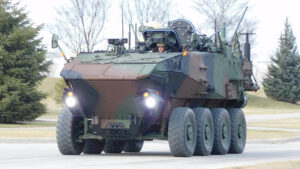General Dynamics Land Systems [GD] will deliver its Advanced Reconnaissance Vehicle (ARV) prototype to the Marine Corps on Friday, the company announced on Wednesday.
The Marine Corps will receive the ARV prototype as well as a blast hull for survivability testing and a system integration lab from GD Land Systems for the program’s upcoming government evaluation period.

“Our purpose-built ARV prototype is the fruition of several years of research and development internally and in collaboration with the USMC. We can’t wait for Marines to get their hands on this ARV and use it as their quarterback on the multi-domain battlefield,” Gordon Stein, GD Land Systems’ vice president and general manager of U.S. operations, said in a statement.
The Marine Corps last July selected Textron Systems [TXT] and GD Land Systems for the 22-month ARV prototyping effort, with each company required to deliver a test vehicle ahead of the government evaluation effort to help inform whether to take the program into production (Defense Daily, July 16 2021).
Textron officially delivered its Cottonmouth prototype for ARV to the Marine Corps on December 1, which followed the company’s own verification testing from August through Nov. 25 (Defense Daily, Dec. 14).
Phil Skuta, GDLS’ director of strategy and business development for U.S. Marine Corps and Navy programs, previously told Defense Daily the company was set to start internal testing of its ARV prototype in August, which follows several years of research and development working with a technology demonstrator and refining its offering through digital design work (Defense Daily, Aug. 9).
“We have continued to align with the Marine Corps’ 10-year transformational initiative, Force Design 2030, and our ARV capability furthers that objective,” Skuta said in a statement on Wednesday. “The ARV is highly mobile on land and in the water and will allow Marines to sense and communicate like never before. Our design also ensures growth margins and modular open architecture to rapidly incorporate new technology as it develops.”
GD Land Systems, which manufactures the Marine Corps’ current Light Armored Vehicle-25s, previously won an Office of Naval Research deal to use the technology demonstrator for a science and technology phase to inform the Marine Corps’ development of ARV requirements.
“During the science and technology phase, for instance, with our earlier technology demonstrator, we put about 60 total nautical miles in the Pacific Ocean on our vehicle,” Skuta told Defense Daily in August. “The testing we’ve done, that really gives us the confidence we have in risk reduction so the Marines know this vehicle is ready for production. We’ve done the testing on the C4/UAS integration, the swim testing, additional blast kinetic testing we do in-house on our own.”
The ARV is set to include a Command, Control, Communications and Computers/Unmanned Aerial Systems, or C4/UAS, payload that will serve as the lead variant for the platform and will allow operators to control both tethered and untethered UAS capabilities.
A Marine Corps sources sought notice released last December detailed plans for the C4/UAS platform and a precision fires version as the first two ARV variants, to be followed by a 30mm cannon version, a recovery variant, a logistics variant and a counter-UAS variant in follow-on phases.
BAE Systems told Defense Daily in May it’s eyeing the ARV program as an opportunity to build out additional variants of its own Amphibious Combat Vehicle (ACV), with the company showcasing a C4/UAS version of the ACV and a new Organic Precision Fires concept vehicle at the Modern Day Marine conference in Washington, D.C. (Defense Daily, May 11).
The Marine Corps has previously tasked BAE Systems with integrating a suite of C4/UAS capabilities onto an ACV to study if such a platform could meet the ARV mission requirements.